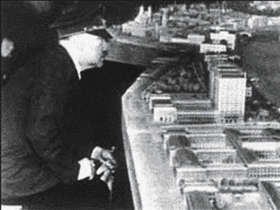Two Must-See Exhibits: “The Cultural Capital of the Führer” and “Political Sculpture”

Kulturhauptstadt des Führers
Copyright: Titze-Clodi. Oberösterreichischer Musealverein, Jb. 88. B., Linz 1939
Linz09’s intensive confrontation with the time of National Socialism now manifests itself in the form of two exhibitions that shed new light on the history of Linz and Upper Austria.
Linz, the city that Adolf Hitler adopted as his hometown, played a very special role during the Nazi era. Major architectural projects and cultural policymaking initiatives were planned for the city on the Danube, though only a few of them ever amounted to anything. Blueprints and images on display in “The Cultural Capital of the Führer” in Schlossmuseum Linz illustrate the practically indissoluble connection between the constants of National Socialist cultural policymaking and Hitler’s megalomania. The exhibition also gives an account of cultural-political everyday life between 1938 and 1945, scrutinizing both continuities and abrupt changes in course. “Political Sculpture,” the accompanying exhibition in Landesgalerie Linz, puts the quotidian consequences of this cultural policymaking agenda into concrete terms by exhibiting the work of four sculptors: Ernst Barlach, Ludwig Kasper, Josef Thorak and Fritz Wotruba. Original pieces of sculpture and historical documents deliver a clear picture of the different ways these works were perceived before, during and after National Socialism.The Cultural Capital of the Führer
17 September 2008 to 22 March 2009
Tuesday to Friday: 9 a.m. to 6 p.m.; Saturday, Sunday & Holidays: 10 a.m. to 5 p.m.; Closed Mondays
Schlossmuseum Linz, Tummelplatz 10, 4010 Linz
Political Sculpture
18 September to 16 November 2008
Tuesday to Friday: 9 a.m. to 6 p.m.; Saturday& Sunday: 10 a.m. to 5 p.m.
Landesgalerie Linz, Museumstraße 14, 4010 Linz





